The Merciless Social Order in India
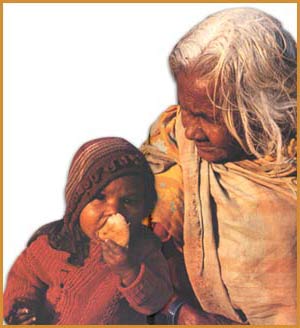
The ruthless caste system condemns many Indians to a life of poverty and want.
The first thing that strikes the visitor to India is the prevalence of destitution, poverty and misery. Daily life is gloomy, filthy and depressing. Beggars, homeless people, and the exceedingly poor are ubiquitous and one does not need to be a sage to realize that they are living in a great deal of misery. One of the foremost causes of this misery is the caste system that has been ruling India mercilessly for over 3000 years known as Jati.
The caste system is the legacy of the Aryans who occupied India between 2500-1500 BC. It is a barbaric social class and hierarchy system devised by the Aryans at the time when they developed the Hindu civilization with the view to continue widespread slavery among Hindus. In this way, they laid the foundations of the racist order that separated their own tall, white-skinned and high nosed race from the indigenous dark-skinned (Munda, Dasyu, Dravid) people. This system continues to this day. Throughout history the caste system has been the fundamental reason behind the killings, murders, arsons, rapes, injustices, conflicts and other social ills prevailing in India. Worst of all, this system formulated by the Aryans, is considered to be a religious necessity based on the so -called sacred scriptures and considered sacrosanct by all Hindus. For this reason the caste system is deeply rooted in Indian society and thus far, no social or legal, local or international pressure has been able to remove it.
The mythical Hindu scriptures base the emergence of this discriminatory system on an exceedingly nonsensical legend, according to which the supposed first human is Manu. From the head of Manu; the priest class, from his arms; the princes and warriors, from his legs; farmers and tradesmen and from his feet, the lower classes were created. In other words, inequalities emerged as the result of this process. This superstitious order in which Hindus have been suffocating for hundreds of years is rooted in this nonsensical myth.
There are four castes subdivided into hundreds of classes:
1-Brahman (Priests and Sages)
2-Kshatria (princes and worriers)
3-Vaikya (traders, shopkeepers and farmers)
4-Sudra (laborers, craftsmen)
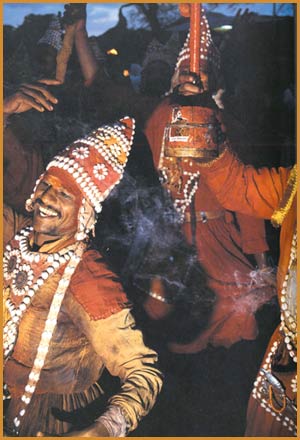
There are various festivals in the Hindu tradition in which idols are revered. Prayers are offered to the accompaniment of strange dances during these festivals, and offerings are made. The fact is, however, that these supposed deities can neither hear their prayers nor see their dances.
Whilst the Aryans took up their places at the top, they termed the lower classes sudra (slave). In this way they created a weak and oppressed society made up of different classes. Sudras were prohibited learning, development and advancement so they were forced to live a miserable life. One’s caste depends on birth and it is not possible to move from one caste to another according to the rules made by the Brahmans. Because of these perverse rules people were destined to live their entire lives without any hope of improving their standing. Then, there are the “untouchables” (dalit- filth that contaminates the upper classes) who are considered as outside the caste system.
The untouchables have been forced to live outside of villages and towns and away from the upper caste people. They are not permitted to enter their temples, schools or to set foot on any public area frequented by them. Neither were they allowed to drink from a well used by the members of the higher castes. Hindu scriptures suggest that making physical contact with untouchables makes the higher caste member impure which then requires highly sophisticated cleansing rituals to be performed by the “contaminated” person. For this reason, untouchables were condemned to live in areas where they would not mingle with the higher caste people, and in many parts of India they were not permitted to walk the streets in daylight, because aside from physical contact, even the shadow of an untouchable was forbidden to fall on a higher caste member, as this is considered to be a “contamination”. Today, these reprehensible practices are legally forbidden but nonetheless still exist across India.
The Brahmans on the other hand, occupied the highest echelons of the caste system and their spiritual superiority, obtained by right of birth, required them to conduct ceremonies and other pagan rituals. According to Aryan texts, Brahmans owned everything on the face of the earth and even if they knew or learned nothing, they were still deemed to be superior. The Hindu author Swami Dharma Theertha sums up this unjust system formulated by the Aryans in the following way:
When the ancient priests set themselves up a an exclusive caste of Brahmans in order to establish their self-assumed superiority, they had to inflict degradation on all other Hindus (i.e., original Indians) and press them down to various layers of subordination. They had to keep the people divided, disunited, weak and degraded, to deny them learning, refinement and opportunities of advancement, and permanently and unalterably tie them down to a low status in society. The Hindu social organization based on hereditary castes was evolved by the Brahmans with the above object and was enforced on the people with the help of foreign conquerors.23
This system, central to Hinduism is comparable to the order established by Pharaoh, cursed by Allah in the Qur’an. When Allah tells us of the situation of Pharaoh, He says that Pharaoh “divided his people into classes”:
Pharaoh exalted himself arrogantly in the land and divided its people into camps, oppressing one group of them by slaughtering their sons and letting their women live. He was one of the corrupters. We desired to show kindness to those who were oppressed in the land and to make them leaders and make them inheritors. (Surat al-Qasas: 4-5)
In these verses Allah reveals that dividing people into “classes” according to race, ancestry, wealth, language, ethnic origin or any other category based on physical criteria is a pagan practice by which people are deprived of their freedoms given by Allah. Allah’s religion requires justice and freedom for people. Islam, revealed as guidance for mankind, delivers this freedom.
For this reason Islam has been instrumental in the liberation of innocent people in India over the past 1000 years and provided a sanctuary for all those who escaped the outrageous cruelty of the caste system. The most important blow ever dealt to the caste system was the spread of Islam on the Indian Subcontinent. The Indian academic Jagjeet S. Sidhu wrote the following in an article in which he compared Islam and Hinduism:
A further barrier to Hindu-Muslim understanding lay in their social differences. Hindu society was based on a caste system according to which every member belonged in a specific social tier. This ranged from the highest caste, Brahmans, to the lowest caste, the Untouchables. To Muslims, Islam was a brotherhood of the faithful devoid of any such caste system. Millions of Hindus who found themselves in the lowest caste converted to Islam in order to escape their misery. This action was never forgotten by the Hindu faithful.24
That is why there is no caste system operating in Pakistan and Bangladesh, both based on Islamic principles and founded by Indian Muslims. However the caste system is still operational in India with all its cruelty and injustice.
The Caste System Is Alive
For a nation to overcome injustice, the root causes of injustice need to be eradicated as well as creating the legal framework required to do so. India is an example for this. The 1949 constitution declared the class of “untouchables” unconstitutional and in the 1950’s, laws that made this practice a criminal offence were passed. However these legal reforms have had little impact on the practices in real life. At present, there are around 250 million people suffering great injustices and are deprived as a direct consequence of the Hindu caste system. In great swaths of the country, untouchables are still considered less than human and therefore cannot participate in social life. The sources that best describe the attitude towards the untouchables are the ancient Manu scriptures, which are held in high regard by Hindus. According to these sources, the untouchables fall into the same category as cockerels, frogs, ducks, moles, dogs or beasts used for transport.25
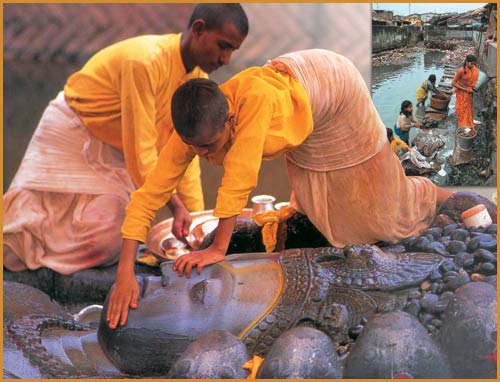
Respect for supposed deities is more important than anything else in Hindu society. Statues of these illusory deities are washed with fresh water, and they are offered the freshest and finest foods. Yet the majority of the people are terribly poor and live under frightful conditions.
The caste system affects every aspect of life in India. It determines everything from the food that can be eaten, who can cook it, how to wash, the color and length of clothing, whether or not men can grow a moustache, even to who is allowed to have an umbrella; nothing is omitted. Punishments are administered according to the caste system too. Whilst a member of the higher castes gets away with little or no punishment for a certain crime, members of the lower castes can expect severe punishment for the same crime. Professions are delegated to the various castes and marriage is only possible within the same caste.
India is the only country on earth that has still such a cruel, unjust and irrational system in place and Hinduism is directly responsible for this. The caste system is a serious threat to social justice, unity, solidarity and peace. The Hindus are irreversibly divided into thousands of castes and sub-castes. The Vedas describe the caste system in great detail and these texts are full of hatred and racism that impose the caste system on the people. India’s first justice minister and co-author of its constitution, Dr. B. R. Ambedkar describes the situation as follows:
Hinduism is a veritable chamber of horrors. The sanctity and infallibility of the Vedas, Smritis and Shastras, the iron law of caste, the heartless law of karma, and the senseless law of status by birth are, to the Untouchables, veritable instruments of torture which Hinduism has forged against untouchables.26
Current examples of the situation described by Dr. Ambedkar can be observed through the airwaves and the printed media. For instance, in March of 2002, 5 dalits (untouchables) were beaten to death and then burned near a police station. Their “crime” was to skin a dead cow but rumors to the effect that they had killed the cow circulated and their fate was thus sealed. The killers’ explanation for their crime came straight from the perverse Hindu belief: “They killed our mother!” they said, referring to the belief that cows are the “mothers” of humanity.27 Such news is common in India where the caste system rules. For example, according to a report by the The Times of India, a member of the lower castes was violently beaten for making contact with the garb of a Hindu belonging to the higher castes.28 The same newspaper printed another report by which members of the higher castes threw animal corpses and excrement into a well used by untouchables, but the police could not be persuaded to take action against the perpetrators.29 An untouchable attempted to participate in a ceremony in a Hindu temple, but was raped and subjected to vicious torture.30 A school expelled 38 Dalit (untouchable) children for attempting to drink from the same water as other children, because according to superstitious Hindu beliefs, dalits are forbidden to drink from the same source as higher caste members.31 On the 11th of July, 1997, the Maharasthra police opened fire on a group of innocent untouchables who were peacefully protesting in Mumbai (Bombay). Thirty untouchables were killed and hundreds wounded. These were not warning shots, but shots meant to kill and many woman and children died in what can only be called a massacre. Later, the police did not permit the wounded to be taken to hospital which increased the death toll further. Following this barbaric attack, the UN called on the Indian government to restore law and order and to bring those who were responsible for this massacre to justice, but nothing concrete came of it. Such attacks, rapes and burnings continue across India.
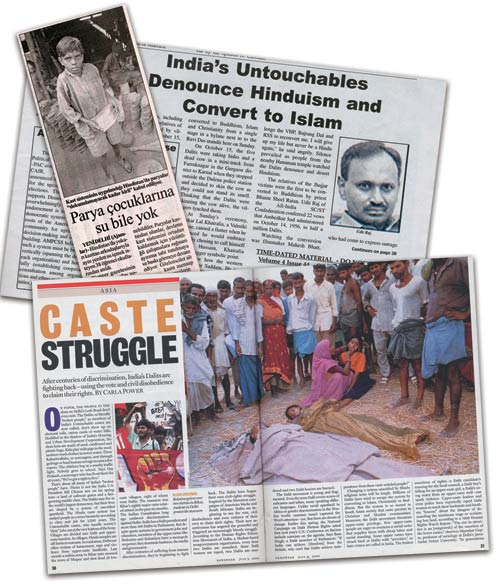
Cumhuriyet, 26 September 2001
The Muslim Observer, 31 October 2002
Newsweek, July 200
Caste Struggle
New conflicts arise just about every day in India and people are ruthlessly killed because of the caste system. A significant portion of the Dalits, exposed to this terrible oppression, abandon the dark teaching of Hinduism and, as in the past, turn to Islam, the representative of justice, compassion and humanity on Earth. A report which appeared in The Muslim Observer on 31 October, 2002, under the heading “India’s untouchables denounce Hinduism and convert to Islam,” described the oppression on the Dalits.
The BBC News reports the ongoing violence and cruelty inflicted on the untouchables as follows:
Despite 50 years of reform, laws banning discrimination and education and economic development, India’s 160 million dalits (about 16 % of the population) are dehumanised in a million ways every day. Why would an upper caste Hindu listen to people deemed so dirty and vile that their very shadow was polluting? Their children are denied education. If allowed into a classroom, they are forced to sit apart, or even outside.
Tea shops have a “two-cup” system which forces dalits to drink from separate cups. In villages, they live in segregated areas, do all the dirty jobs, cannot draw water from the same well as the higher castes or worship in the same temples.
Most are landless labourers at the mercy of landlords who will not flinch from lynching, raping and burning their huts if dalits dare to answer back or even defend themselves against abuse. A prize-winning Indian journalist, P Sainath, has described a dalit man’s nostrils being pierced with a packing needle and a string drawn through his nose by upper-caste villagers in Rajasthan. His tormentors held the string like a horse’s reins, made him walk in the streets and later tied him to a peg meant for cattle. Woe betide dalits trying to better themselves.
A couple of years ago, a young village woman in the southern state of Tamil Nadu found a job as a social worker in the nearest town. The first time she returned to visit her family, the upper castes fell into a rage because she had been “uppity” enough to wear shoes. She was manhandled and paraded naked for not knowing her place. 32
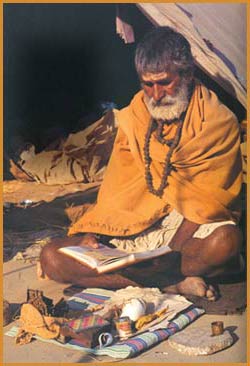
Sadhus (Hindu ascetics) are Hindus who abandon the established order and their families and who begin living in the streets in order to draw closer to the so-called Brahman. This Hindu tradition encourages idleness and laziness instead of hard work in this world, and condemns people to live under very primitive conditions. Yet the moral values of Islam encourage people towards dynamism, to strive to attain ever more pleasant things, and to perform deeds that will be beneficial to others. In contrast to the dark and dirty world of Hinduism, that of Islam encourages a clean, enlightened and peace-filled life.
Eric Margolis, a Canadian journalist with the Toronto Sun newspaper, described the inhuman system ruling in India in an article written in 2001 and titled “India’s Hidden Apartheid”, as follows:
Fair-skinned Brahmins, 3.5% of the population, are India’s ruling elite, holding 78% of judicial positions and half of parliament’s seats. In recent tests, Indian scientists discovered that high-caste Hindus, particularly Brahmins, are genetically closer to Europeans than they are to dark-skinned, Dravidian Indians. Caste became a rigid system whereby India’s fair-skinned ruling class kept lower and swarthier others in their places - as laborers, landless peasants, and servants - exploiting them in the name of religion……
Dalits are forced to clean public toilets and remove human feces, usually with their hands. They sweep up after Indians defecate in the streets and move dead animals. According to an extensive report on caste by the respected Human Rights Watch, large numbers of Dalit women are routinely raped and forced to become sex slaves for Hindu priests and land owners. Of India’s estimated 40 million indentured laborers - a modern form of slavery - most are Dalit children, often sold into lifelong servitude by starving parents.
When Dalits try to defend themselves from abuse and exploitation, they are attacked by higher-caste gangs and local police. Their shanties are burned and their women gang raped. Dalits, like Muslim Kashmiris, are frequently subjected to beatings, rape, torture and arson by India’s brutal police, says Human Rights Watch.33
A considerable number of these “defenseless” dalits find the solution in leaving the dark world of the Hindu faith, as before in history, for a religion that represents justice, compassion and humanitarianism: Islam. According to a report by BBC News:
At least 400 members of the low caste (Dalit) community in the southern Indian state of Tamil Nadu, say they are planning to convert to Islam, because of what they describe as persistent unfair treatment by their higher caste Hindu neighbors. In the latest incident, the Dalit leaders are angry that higher caste Hindus in their village, near Kanchipuram have refused to allow a religious procession to pass through the streets where they live.
… The dalit community says they are not being coerced into converting to Islam, but they want to because in Islam everyone is treated equally.34
The reality that can be recognized so easily even by these people who have no in-depth knowledge of the Islamic faith is exceedingly important: whereas the superstitious Hindu religion oversees the rule of a cruel social system of caste segregation that sanctions the oppression of the poor by the rich and the weak by the strong, the Islamic morality commands justice, to do good, to act in goodwill, to respect the rights of other people, and to maintain devotion and compassion towards others. Therefore, in a society in which Islamic morality rules, people will at always side with the truth, will not compromise on honesty, and will invariably opt for righteousness. Allah says the following in the Surat Al-Ma’ida:
You who have faith! Show integrity for the sake of Allah, bearing witness with justice. Do not let hatred for a people incite you into not being just. Be just. That is closer to heedfulness. Have fear of Allah. Allah is aware of what you do. (Surat al-Ma’ida: 8)

… Be equitable when you speak–even if a near relative is concerned; and that you fulfill Allah’s contract. That is what He instructs you to do, so that hopefully you will pay heed. (Surat al-An‘am: 152)
Allah clearly reveals true justice in great detail in the Qur’an and informs us that if true Qur’anic morality is practiced in society, injustice cannot prevail and people will live in peace and happiness. In the Indian society which we have examined thus far, and also in many other countries of the world, people suffer from great injustices because of the color of their skin, because of their religious denomination or because of their race or ethnicity. People of white skin are treated differently to black people, who are often discriminated against. For centuries, especially in the past two centuries, racially motivated wars were fought across the world in which tens of millions perished. The morality of the Qur’an does away with such divisive factors. Allah reveals the reason for creating different races and nations:
Mankind! We created you from a male and female, and made you into peoples and tribes so that you might come to know each other. The noblest among you in Allah’s Sight is the one of you who best performs his duty. Allah is All-Knowing, All-Aware. (Surat al-Hujurat: 13)
Allah willed to create His servants as different nations or tribes in order for them to acquaint themselves with one another, with each others cultures, languages, traditions and achievements. The fact that different races and nations co-exist must be considered as cultural diversity and as such, it should prevent conflicts and war between them. This diversity is the beauty in Allah’s creation. Just as being tall or white cannot be the basis for supremacy as opposed to being short, yellow or black, it can neither be considered as inferiority. Such is Allah’s will and wisdom; and in the Presence of Allah these differences have no bearing. Believers know very well that the only measure of superiority is the superiority in faith and fear of Allah.
In one verse we are told:
Among His Signs is the creation of the heavens and earth and the variety of your languages and colors. There are certainly signs in that for every being. (Surat ar-Rum: 22)
Allah has created all different races according to His wisdom and Muslims must be just to all people and races, even if they are deniers:
Allah commands you to return to their owners the things you hold on trust and, when you judge between people, to judge with justice. How excellent is what Allah exhorts you to do! Allah is All-Hearing, All-Seeing. (Surat an-Nisa’: 58)
Allah’s recommended sense of justice requires treating everybody as equal, compassionately, and as peacefully as humanly possible without discriminating against one or the other. Our Prophet Muhammad (may Allah bless him and grant him peace) stated that: “All people are from Adam (pbuh) and Adam (pbuh) is from dust”35, hence we are all equal, as the human race. People’s color, race, ethnic origin or language do not define supremacy or inferiority.
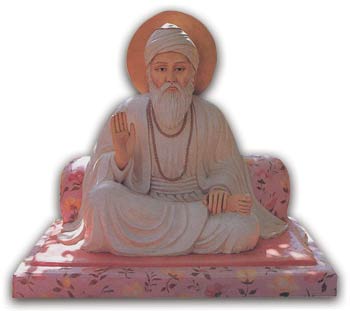
Guru Nanak added such superstitious Hindu traditions as reincarnation and karma his newly invented faith.
For a Muslim and in Islam, someone’s social status in terms of wealth or poverty or his categorization into upper or lower class is of no relevance. Allah’s decree in this regard is clear:
“... Be upholders of justice, bearing witness for Allah alone, even against yourselves or your parents and relatives. Whether they are rich or poor, Allah is well able to look after them. Do not follow your own desires Allah…” (Surat an-Nisa’: 135)
According to this commandment of Allah’s, a faithful believer who sincerely and respectfully fears Allah must be just to everyone, irrespective of wealth or poverty, and cannot discriminate or treat someone differently because of his financial or social status. He knows that wealth and poverty are temporary circumstances of this world, created by Allah in order to test people. When death comes, people’s worldly wealth and property lose all their value and the only thing that matters then is his fear of Allah, Who values only truthfulness, justice, honesty and decency. One of Allah’s verses on justice is the following:
You who have faith! Be upholders of justice, bearing witness for Allah alone, even against yourselves or your parents and relatives. (Surat an-Nisa’: 135)
As this verse demands of the believers, they must strictly abide by Allah’s verses and they cannot compromise on justice under any circumstances. It is evident that preferential and discriminatory treatment purely based on blood bonds or friendship will create discontent and friction in society. A Muslim acting on the principles of the Qur’an will comply with Allah’s commandments, as in the following verse:
… That you are equitable when you speak – even if a near relative is concerned; and that you fulfill Allah’s contract. That is what He instructs you to do, so that hopefully you will pay heed. (Surat al-An‘am: 152)
Abiding by these instructions is evidence for a Muslim’s strong faith in Allah and his good character.
This is the social model prescribed by the morality of the Qur’an. Hinduism on the other hand is not based on Allah’s revelation. Consequently, it has produced a vicious, oppressive, loveless and racist system.
The False Hindu Religion And Sikhism
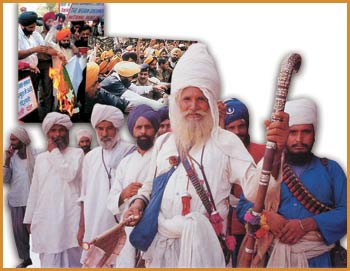
Looting and attacks on Hindus by Sikhs demanding independence were met with violence by the Hindu security forces, leading to major conflict. It is estimated that thousands of Sikhs were killed in a Hindu operation in 1984.
The caste system in the superstitious Hindu religion has been the source of terrible oppression of the great majority of that faith’s members throughout the course of its history. For that reason the morality of Islam with its affection, justice, and social solidarity has been the hope of many Hindus. As we have already mentioned, since the arrival of Islam in India, a considerable number of Hindus have become Muslims. However, certain sections of society have found it difficult to escape the Hindu traditions they have lived with for so long.
These people neither walked away from Hinduism completely nor did they enter Islam, but instead tried to create a new religion, in their own eyes, by mixing the two. One such attempt produced Sikhism, which was founded by Sri Guru Nanak Dev Ji (1469-1539).
Guru Nanak worked for many years under Muslim leaders where he had the opportunity of getting to know Islam intimately. He met many Islamic scholars and learned from their views and eventually, he formulated a new culture in his own mind by fusing certain elements of the Hindu faith with some of the core principles of Islam. His school of thought found many followers over time and Sikhism was thus born.
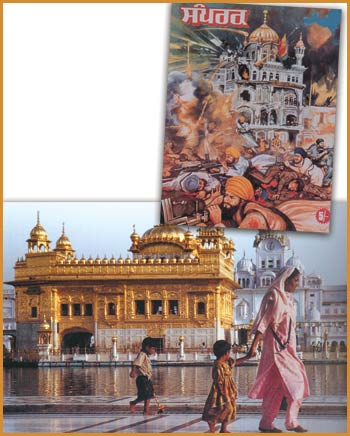
An illustration depicting “Operation Blue Star,” initiated against the Sikhs by Indira Gandhi. Below is shown the Golden Temple of Amritsar, which is sacred to the Sikhs.
Sikhs are concentrated in Pencab, North-western India. According to a population count conducted in 1995, they number 18.7 million people, 1.9% of India’s total population. They live also as small minorities in Britain, Canada, USA, Malaysia and East Africa.
Sikhism acknowledges true Islamic principles such as the unity of Allah, and that He created the whole universe from nothingness, that all people are equal and that together, they form the human brotherhood. Sikhs reject the caste system and idolatry but believe in reincarnation, karma and nirvana, aspects taken over from the false religion of Hinduism. Many Hindu traditions, festivals and rituals are practiced by Sikhs too.
Superstitious karma and reincarnation are prominent features of Sikhism, and it is believed that the nine gurus who succeeded Guru Nanak each carried the soul of his predecessor. This system of succession ended with the 10th guru Gobind (1675-1708). However the ten gurus are deeply revered by the Sikh community and every Sikh has the portraits of them in his home. Devotion to these gurus is considered elementary to the Sikh faith.
The name Sikh became widely known in the world with the attacks carried out across India by Sikh militants. At present, Sikhs are in a state of conflict with Hindus as well as Muslims. Thousands of Muslims have lost their lives over the years at the hands of Sikh militants in Kashmir, but the loss of life in their conflict with Hindus is even greater.

The burning of the body of Indira Gandhi, killed by Sikh militants.
When in 1947 Pakistan broke away from India, the Sikhs were very influential in Pencab, but with the division of the country, they were dispersed to various parts of the country. As a consequence, they lost their military and political power. Between 1941 and 1951 200,000 Sikhs were forcibly converted to Hinduism in an assimilation campaign which triggered the ongoing conflict between Hindus and Sikhs. The Sikhs are known to be a more proactive, aggressive and uncompromising people compared to other societies on the Indian subcontinent and “support” their demand for independence with violence, arson and occasional acts of terrorism. The conflict escalated further when in 1984 Hindus invaded the Amritsar Temple, a holy site of the Sikh faith, and killed between 450 and 1,200 Sikh militants in an armed conflict that lasted four days and nights. The Sikhs responded soon after by having the late Prime Minister Indira Gandhi, who had ordered the assault on the temple, killed by her two Sikh body guards. The Hindu regime then began a wide-ranging operation against the Sikhs. Official figures put the Sikh casualties at 2,700, but according to Human rights organizations and the media, the death toll was likely between 10,000 and 17,000.36 Sikh militants went on the counter attack by assassinating prominent Hindus as well as moderate Sikh leaders who opposed their policies. Since 1984, 30,000 people have been killed in the conflict between Sikhs and Hindus. The 1990’s saw a decrease in violent attacks, but with the rise of Hindu ultranationalism in recent years the conflict has began to escalate again.
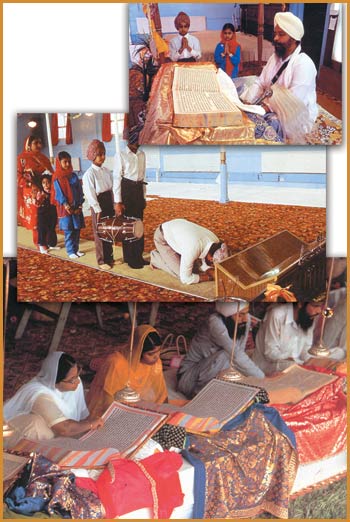
The Sikhs’ holy scripture is called the "Granth Sahib." Sikhs regard these texts as the foundation of their faith and engage in heretical demonstrations of respect in front of them.
As we stated at the beginning, Sikhism is a manmade religion which incorporates some elements of Islam, but continues Hindu practices and mixes the two, which is not a rational thing to do.
Islam is a religion based on Divine revelation whereas Hinduism, on the other hand, is a religion based on preposterous human traditions developed by human beings. Revelation is Divine knowledge that comes from Allah and is therefore absolute, whereas traditions and other human views and practices are inevitably flawed and imperfect. Additionally, Hinduism when compared to most other man-made cultures and systems is even more nonsensical, bigoted, violent, unjust and perverse. It is therefore a grave perversity to produce a religion between Islam and Hinduism.
Sikhism is the product of an error that has misled many people throughout history; blind devotion to traditions. Allah says the following about people who fall for this mistake:
When they are told, “Come to what Allah has sent down and to the Messenger,” they say, “What we found our fathers doing is enough for us.” What! Even if their fathers did not know anything and were not guided! (Surat al-Ma’ida: 104)
We sincerely call on all Sikhs to acquire the dignity of Islam by following only Allah’s religion, instead of submitting to “the religion of their forefathers.”
Hinduism Condemns People To Destitution And Hunger
One of the negative aspects of the belief in karma at the core of Hinduism is that the illnesses, poverty, helplessness and disabilities of people are perceived to be a punishment for their evil deeds or from the moral misconduct of their previous lives. As a result, people in the lower caste believe they deserve to be punished and society as a whole thinks that way too. The rich and the ruling class at the top of the system consider their privileges to be their natural right. Because of this erroneous belief, people of the lower castes have always been debased and oppressed in Indian society.
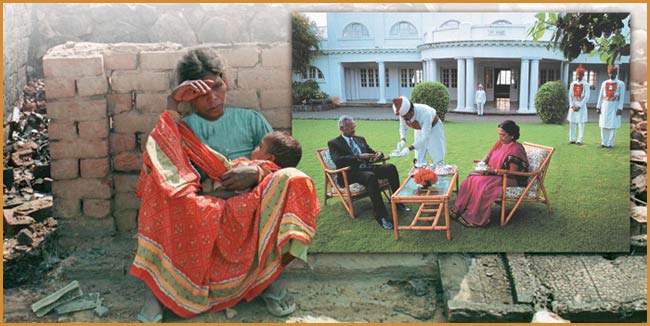
The caste system gave rise to a most unfair social order in India. The upper castes, constituting only a very small part of the population, continue to live under very pleasant conditions, while the “untouchables” struggle against poverty and want.
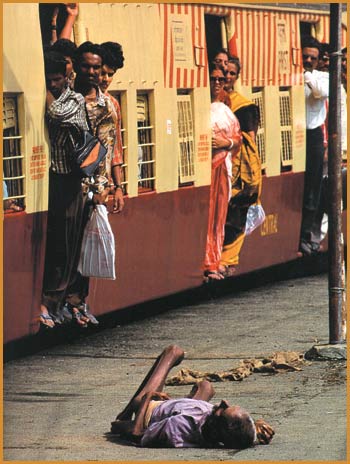
The ruthless caste system has made Indian society insensitive to the sufferings of the lower classes.
According to the rigid caste laws of Hinduism, people belonging to the lower castes cannot change their caste whilst in this life. Therefore, they can neither improve their social status, change their professions or improve their living standards. The only thing they believe they can do is to comply with the social order without complaint and hope thereby to be born into a higher caste in their next reincarnation. Otherwise, they believe they will be returned as plants or animals. But who is actually evaluating the conduct of people and determining their biological form for their next lives? Hindus cannot answer this question. The only thing they can do is to believe that the laws of the imaginary karma system function like the “self-governing natural laws”. However it is evident that there cannot be any such “natural laws” and this makes the irrationality of this belief obvious. Moreover, the Hindus as well as other believers in karma like Buddhists have been raised with this type of conditioning and they therefore believe blindly in this imaginary system. These false beliefs gave rise to and perpetuate an oppressive caste system that condemns people to be kept at a certain social level.
The caste system in the Hindu belief eradicates cooperation, solidarity and the support of the needy within the sociocultural structure, because the uncompromising caste system creates an environment in which people regard one another as opponents and those outside the four castes, specifically the untouchables, are subjected to inhuman treatment. These people have been forced to work in the least desirable jobs, are not helped by anyone if they go hungry, and are debased and dejected in the most appalling fashion. Hindus believe that the poor are poor because they deserve it, so they refuse to help them. The sick, the needy and the disabled are disregarded. Hinduism is the most debasing religion for people. The most highly praised things in Hinduism are their idols and deities, and that is why Hindus derive joy and happiness from serving and prostrating before lifeless idols they made themselves from wood or stone. A so-called sacred tree, snake, worm or cow is valued higher than a human being in Indian society. No other religion belittles and disrespects humanity as Hinduism does.
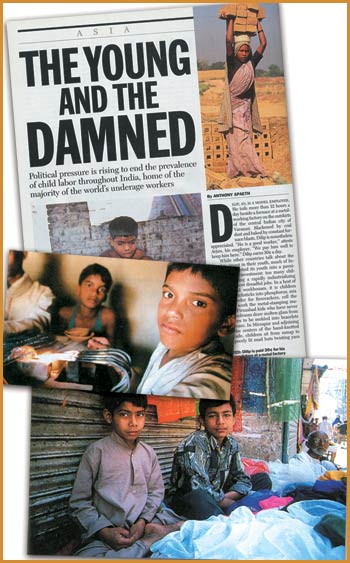
Time, 16 April 1996
Young and Cursed
There are some 15 million child workers in India. The Time report shown to the side described how India was coming under intense political pressure from a number of countries to put an end to this ruthless system.
Since the sense of solidarity is lacking in the state administration, destitution is increasing across the country by the day. Members of the higher castes represent approximately 15% of the Indian population but control roughly 90% of the national wealth, media, security forces and the justice department. Overall, 40% of the people live in abject poverty, which means that almost 400 million people lack the bare necessities of life like food, shelter and clothing. This is a staggering figure. The organization Human Rights Watch estimates that 15 million children are indentured servants; these are children given in ransom for their families debts, and constitutes a form of slavery.37 It is also estimated that a further 8 million children are doing hard farm labor. The Times of India newspaper reported on the 11th of April 1984, that these children live under conditions reminiscent of “torture camps”.38 «Çocukların Kölelikteki Özel Durumu, Turizm, Çocuk Seks Ticareti ve Köleligi», (The Special Position of Children in Slavery, Tourism, the Child Sex Trade and Slavery), Irfan Erdogan, Ankara University, They spend their lives fighting off starvation. Hindus receive such news complacently as they consider this destitution justified by the caste system and have no qualms when they make the most expensive food offerings to their self-made idols. India is a country where this irrational system is regarded as not only highly commendable, but highly reasonable, and where food is given to statues rather than the hungry.
India’s education system is nothing to be proud of either. Approximately half of all children between the age of 6 and 14 are either working or do not attend school for other reasons. The state education system is neither compulsory nor fair.39 Poor people simply cannot afford school uniforms, transport or educational material. The education system’s significant failings are partly due to the fact that education is considered by many, including the government, as unnecessary for the members of the lower castes.
This is a cruel system that can only exist in idolatrous societies devoid of religious morality. It is unjust and contrary to the morality of the Qur’an. Allah reveals in the Qur’an that all weaknesses and destitution is given to mankind as a trial for their conduct in this world. Allah says: “We will test you with a certain amount of fear and hunger and loss of wealth and life and fruits. But give good news to the steadfast.” (Surat al-Baqara: 155) Sickness or poverty is not a punishment, but a trial, and people are expected to be patient and moral despite the hardship and to lead a life that will earn Allah’s good pleasure. The approach that should be adopted toward those in want and trouble is to help without giving offence, to protect their rights and to watch over these people in the best way.
In true religions based on Allah’s revelation, doing good, cooperation and solidarity are central to inter-human relations. Our Lord says:
… Help each other to goodness and heedfulness. Do not help each other to wrongdoing and enmity. Have fear of Allah. Allah is severe in retribution. (Surat al-Ma’ida: 2)
As revealed in the above verse, Muslims are obliged to make genuine efforts in the cause of the good. They ponder Allah’s verse, “Whatever good you do, Allah knows it.” (Surat an-Nisa’: 127), and never forget that whatever they do, they will get its reward in the Presence of our Lord Allah. In the verse below, Allah reveals that solidarity must be within the framework of goodness and fear of Allah and the Qur’an also reveals what goodness is:
It is not devoutness to turn your faces to the East or to the West. Rather, those with true devoutness are those who believe in Allah and the Last Day, the Angels, the Book and the Prophets, and who, despite their love for it, give away their wealth to their relatives and to orphans and the very poor, and to travellers and beggars and to set slaves free, and who perform prayer and give the alms; those who honor their contracts when they make them, and are steadfast in poverty and illness and in battle. Those are the people who are true. They are the people who guard against evil. (Surat al-Baqara: 177)
As our Lord reveals in the Surat al-Baqara, goodness is a morality that encompasses all aspects of a Muslim’s life as well as being an ongoing state of worship. Muslims are people who help the needy and orphans, even if they are needy themselves, who give from what they like for themselves (Surat al-Insan: 8) and who are devout servants of Allah. They recognize solidarity, cooperation and doing good as an attribute of being a Muslim. “And beggars and the destitute received a due share of their wealth.” (Surat adh-Dhariyat: 19). Their assistance for others is not dependent on anything and Muslims go any length in order to do good and to encourage others to do likewise. His help seeks no return just the good pleasure of Allah. Our Prophet (may Allah bless him and grant him peace) said in one of his Hadith: “Allah Who is great said: My servant, give provisions to the needy so I may give to you”40
Allah reveals in the Surat al-Insan muslim’s behavior:
“We feed you only out of desire for the Face of Allah. We do not want any repayment from you or any thanks. Truly We fear from our Lord a glowering, calamitous Day.” (Surat al-Insan: 9-10)
Muslims know that Allah is infinitely just and they never forget that they will be rewarded for the good they do on earth. They bear in mind that life on earth is a temporary affair and that the true life is awaiting them in the Presence of Allah, because this is what Allah reminds them of and He advises them to do good. The reward for those who do good is revealed by Allah in the verses as follows:
When those who have fear of Allah are asked, “What has your Lord sent down?” their reply is, “Good!” There is good in this world for those who do good, and the abode of the hereafter is even better. How wonderful is the abode of those who guard against evil. Gardens of Eden which they enter, with rivers flowing under them, where they have whatever they desire. That is how Allah repays those who guard against evil. (Surat an-Nahl: 30-31)
Superstitious Hindu Religion Ordains The Ill-Treatment Of Women
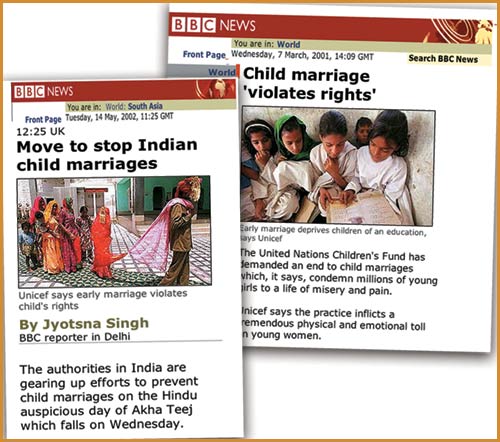
A report on the BBC web site described how human rights were neglected in terms of child marriages. Despite being legally banned, these ceremonies, which take place en masse and in front of large audiences, are prevented neither by the security forces nor by the civilian administration. , A BBC report titled "Move to stop Indian child marriages" described how thousands of children, and even babies, are forced into arranged marriages every year.
BBC, 7 March 2001 , Child marriages “violates rights” , BBC, 14 May 2002
In the previous chapters of this book we examined the erroneous teachings of Hinduism including its discriminatory social order that reduces human beings to a lower status than animals. The Hindu religion’s discrimination of the lower castes and other religious denominations is nothing in comparison to its viciousness towards women. Hindu written texts contain special prohibitions and restrictions in terms of women’s daily lives. All these illogical rules make their daily lives very difficult. In comparison to men, Hindu women are like slaves and they are forbidden to seek even the most basic human rights.
There are countless restrictions and oppressive traditions that are imposed on women in many different countries of the world, but the superstitious traditions in India present violence, oppression and every form of degradation in the guise of sacredness to people. That is why Hindus see the violation, degradation and ill-treatment of women as a religious obligation. The Manu, one of scriptures of the superstitious Hindu religion, speaks of women in the following way:
“A dead-end of incapacity, this dead-end of immorality, this congregation of fire, this obstacle in the human eye, this portal to hellfire, this false flower basket, the elixir of the venomous secret, this chain that ties people to this worthless life or, in one word, woman…”41
Some of the barbaric practices inflicted on women, driven by ancient superstitious traditions, some priests and religious texts, are as follows:
-The Manu (one of the more important scriptures of Hinduism) speaks of women as the “cookers of dogs”. According to its commandments women have no right to own property. Women are allowed to work and earn, but their earnings belong to their fathers, husbands or if the woman is widowed, to her son.
-Women are prohibited from making independent decisions and even to seek this right is forbidden in the Manu.
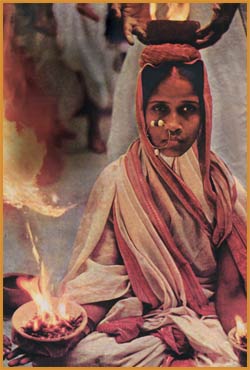
According to nonsensical Hindu belief, evil begins in the human brain, and is then set in action by the hands. Hindus therefore believe that these evils need to be chased away with fire. The women in the illustration is holding burning bowls in her hands, while a Hindu priest carries one on his head. The only reason why Hindus perform these superstitious ceremonies is that they have been handed down to them from their forefathers. But were they to subject their actions to logic and reason, and act as their conscience dictated, they too would see how what they do is a complete deception.
-The right to divorce is given to men only. Irrespective of whatever cruelty, oppression and violence she may be subjected to, she cannot divorce her husband. Under all circumstances she must obey her husband and be grateful for the treatment she receives. According to the Manu, “even if the husband has nothing noteworthy about him, she must respect him as her lord”.42 (Allah forbid) This perverse belief is visible in everyday life. In earlier times Aryan men had the right to cut off their wives’ ears and noses if they left their houses without the permission of their husbands. This practice still continues in less developed parts of India.43
-Irrespective of their caste, all women are prohibited from reading the major part of educational textbooks. Women are also prohibited from reading or learning the Hindu scriptures, the Vedas in particular.
-The drahoma, or dowry received by men is another example of cruelty. This practice was outlawed in 1961 but is still a common practice in India. What makes it so significant is the fact that it is used to oppress, hurt and violate women. During the marriage ceremony the bride’s family pay the groom’s family a huge sum of money and even after marriage, the groom’s family will continue to demand money or property and often resort to violence in order to obtain it. Some men seek to remarry in order to receive another drahoma and burn their young wives to death for this purpose. These killings are covered up as suicides or accidents, which explains the exceedingly high rate of accidental deaths in households.44
In India, families that have girls, live in gloom because of the Drahoma, they have to give, as well as turning a blind eye to their daughter’s treatment. The possibility of determining the sex of the child during pregnancy, forces the anxious people to unspeakable barbarism. The Times of India newspaper printed articles to the effect that pre natal tests are increasingly accurate, bringing in its wake rising numbers of abortions. The same year, research conducted in Bombay revealed that out of 8000 abortions, carried out after such tests, all aborted fetuses were female except one.45 The new centre for eugenics, a “science” developed by Darwinist theorists and cruelly implemented in Nazi Germany, is India.
-The murder of girls is a direct result of ancient Hindu texts ordaining cruelty to women. This vicious tradition is ordained, sanctioned and traced back to Aryan texts: “Hence they [Aryans] reject a female child when born, and take up a male.”46 The Atharva Veda commands, « Let a female child be born somewhere else; here, let a male child be born”47 A woman giving birth to a daughter feels she has committed a crime. Killing newly born baby girls is seen as an easy “opt out clause” from the burden of raising girls.48
The inhuman practices girls are subjected to has existed throughout history in various societies that did not practice religious morality. This Aryan practice existed in many other cultures as well, and one of these was the pre-Islamic Arab society. Allah reveals that Arabs did not value baby girls, and that they buried them alive straight after birth; they will be brought to justice for this sin on the Day of Judgment:
When the baby girl buried alive is asked for what crime she was killed, (Surat at-Takwir: 8-9)

Nandalal Bose's painting "A Woman Going to Suttee”
In another verse, Allah reveals that the idolaters were wrong to feel shame for having conceived a girl:
When one of them is given the good news of a baby girl, his face darkens and he is furious. He hides away from people because of the evil of the good news he has been given. Should he keep her ignominiously or bury her in the earth? What an evil judgment they make! (Surat an-Nahl: 58-59)
In the following verse Allah states that this practice is madness:
When any of them is given the good news of the very thing which he himself has ascribed to the All-Merciful his face darkens and he is furious. (Surat az-Zukhruf: 17)
Allah reveals with the following verse that it is Him Who determines the sex of each human being:
The kingdom of the heavens and earth belongs to Allah. He creates whatever He wills. He gives daughters to whoever He wishes; and He gives sons to whoever He wishes; or He gives them both sons and daughters; and He makes whoever He wishes barren. Truly He is All-Knowing, All-Powerful. (Surat ash-Shura: 49-50)
It is Allah Who wills the birth of boys as well as girls and parents are expected to raise them in love, affection and compassion as recommended by Allah.
Throughout history, Islam forbade the barbaric practice of infanticide of idolatrous religions wherever it went and brought such practices to an end. Allah has taught nations unaware of the Islamic morality the wrongness of this attitude towards girls through His messengers and the books of revelation. With the teaching of the Islamic morality delivered by prophets, being acquired by people, the thought of girls being a cause for embarrassment and the aforementioned barbaric practices of ignorant societies have almost been eradicated. However, India is still persists in its ancient and perverse practices of killing baby girls.
The Horror Of Sati Or The Burning Of Widows
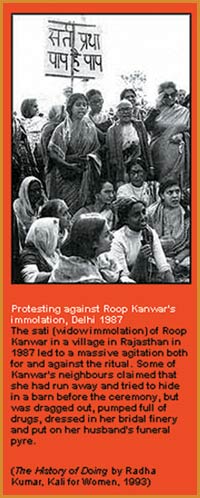
Major demonstrations took place in the country following the killing of Roop Kanwar. Some of these demonstrations took place in order to defend the savage ritual known as suttee, and others in order to protest against Kanwar’s killing.
The perverse practices ruling social life in India are too numerous to recount. Each of these superstitious beliefs has its own rituals and variations according to the area but the most horrific of them all must be the “suttee”, killing hundred of thousands of women over the centuries. This perverse tradition requires widows to die by burning upon the death of their husbands.
The horrific suttee tradition began to be practiced at the time of the Aryan’s conquest of India. In the case of an individual woman this practice is termed suttee but when whole towns or villages are affected, it is called Jauhar (instances of war when the men are not expected to return). The reason for this burning of women is to punish them for not dying before their husbands. In the case of Jauhar, innocent women are cooked, cut in two and fed to the dogs. Superstitious Hindu traditions also contain explanations aimed at justifying this horrible practice. For example, some Hindu texts speak of “Jauhar” as being to prevent the women from falling into the hands of the enemy.49
The Indian writer Sita Agarwal, whose sister was killed at a young ag by the practice of drahoma, says in his book “Genocide of Women in Hinduism” written in 1999, that the practice of suttee is found in all Hindu texts, that it has been practiced by the Brahmans throughout the centuries, and that it continues to be a widely practiced tradition50 Some of the commandments in relation to suttee found in the Manu, considered to be so-called Divine revelation, are as follows:
Let these women, whose husbands are worthy and are living, enter the house with ghee (applied) as corrylium (to their eyes) let these wives first step into the pyre, tearless without any affliction and well adorned.51
A sati who dies on the funeral pyre of her husband enjoys an eternal bliss in heaven.52
It is the highest duty of woman to immolate herself after her husband.53
The suttee tradition that turns a good quality like loyalty to the husband into a horrific act of barbarism has been responsible for the burning of countless women through the ages. Hindu women sometimes willingly surrendered to this tradition, but were more often than not burned by the force of society. Suttee is at present legally prohibited but still widely practiced in India, especially in rural areas. Cases of suttee are usually entered into public records as death by household accidents or kitchen fires, but sometimes they are a public ritual; for instance, in 1987 a young woman by the name of Roop Kanwar was killed in a suttee ritual at her husband’s funeral in Deorala, a village in Rajasthan, reopening the suttee debate. Roop’s burning was defended by her family, the local population and many Hindu leaders, by claiming that it was her own choice, whereas others suggested that the young woman was burned forcefully by her family and the Brahmans.54
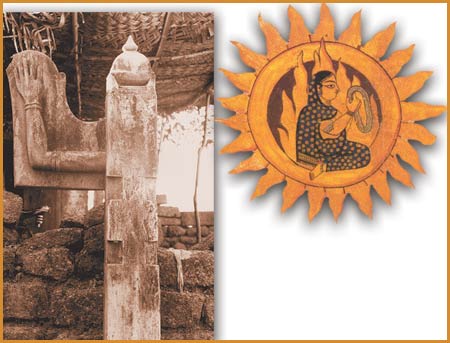
(Above) According to Hindu myth, the wife of the fictitious deity Rama through herself into the flames in the wake of his death, but the fire did not hurt her.
(Side) A monument to women who committed suttee. Hindus believe that women who perform this savage tradition attain a holy state, and make offerings to these shrines.
In these ritual burnings, the Brahmans, rulers of the caste system, played a leading role through the ages. They encouraged suttee and presided over the rituals and currently, it is the Brahmans again who are leading the pack in the race to revive this tradition. According to Agarwal, there are two main reasons for the Brahmans to support the revival of the suttee tradition, especially the killing of the widows of other castes:
1-To reduce the numbers of non-Brahmans by killing their women
2-The appropriation of the women’s property by the Brahmans
The second reason cited here is recorded also by the French traveler Jean Baptiste Tavernier who visited India 6 times between 1641 and 1667. He was a jeweler who visited India on business, which is why his observations are considered to be credible and impartial, and his writings reflect a certain admiration for India. However, like other observers, he too was shocked by the frequent killings of other caste members by the Brahmans. He wrote:

(Side) A report in the Swiss Neue Zürcher Zeitung called ”Emancipation for Indian Women” described how discriminatory policies against women still continue in India. (Center) A report headed “Bride Burning Still Goes on in India,” published by CNN, described various cases of suttee and interviews with individuals who had been saved from committing suttee at the last minute. Young, the author, stated that some 5000 cases of suttee take place every year, but that most are written off as domestic accidents.
The Brahmans accompanying her (the Sati) exhort her to show resolution and courage, and many Europeans believe that in order to remove the fear of that death which man naturally abhors, she is given some kind of drink that takes away her senses and removes all apprehensions which the preparations for her death might occasion. It is for the interest of the Brahmans that these unhappy women maintain the resolution they have taken to burn themselves, for all the bracelets which they wear, both in arms and legs, with their earrings and rings, belong of right to the Brahmans, who search for them in the ashes after the women are burnt.55
Tavernier’s account aids the visualization of this shocking tragedy. The fact that the Brahmans first encourage the widows to suttee, then burn them with their own hands and finally pick the valuables from the ashes demonstrates that the Hindu traditions are a horrific means of exploitation. Tavernier relates the details of this tyranny:
“I have seen women burnt in three different ways, according to the customs of different countries. In the kingdom of Gujarat; and as far as Agra and Delhi, this is how it takes place: On the margin of a river or tank, a kind of small hut, about 12 feet square, is built of reeds and all kinds of faggots, with which some pots of oil and other drugs are placed in order to make it burn quickly. The woman is seated in a half-reclining position in the middle of the hut, her head reposes on a kind of pillow of wood, and she rests her back against a post, to which she is tied by her waist by one of the Brahmans, for fear lest she should escape on feeling the flame. In this position she holds the dead body of her husband on her knees, chewing betel all the time; and after having been about half an hour in this condition, the Brahman who has been by her side in the hut goes outside, and she calls out to the priests to apply the fire; this the Brahmans, and the relatives and friends of the woman who are present immediately do, throwing into the fire some pots of oil, so that the woman may suffer less by being quickly consumed. After the bodies have been reduced to ashes, the Brahmans take whatever may be found in the way of melted fold, silver, tin, or copper, derived from the bracelets, earrings, and rings which (p.166) the woman had on; this belongs to them by right, as I have said.»56
The whole world considers this suttee practice as barbaric, the Hindu mind justifies it with a twisted rationale; a loyal widow’s transcendence of the fear of her own death becomes a deity by accomplishing this ritual.
It is noteworthy that the first prohibition of this ancient Indian tradition was enacted by Muslims. The Encyclopaedia Britannica states that the first people who attempted to eradicate the suttee tradition were the Muslim Mongol empire’s rulers, Humayun and his son Ekber, who governed India between 1526 and 1707.57 The British rulers who succeeded the Mongols in India formally declared the suttee tradition unlawful when the British viceroy William Bentinck proclaimed this new law in 1828. Though the suttee tradition all but vanished in most of the country, in rural towns and villages the suttee tradition still lives on among the Hindu fundamentalists.

A report titled “VHP Resurrecting Suttee” carried in the Indian daily the Deccan Herald. Deccan Herald, 8 February 1999
What is even more worrisome than the acceptance of this barbarism by the uneducated and ignorant Hindu masses is the fact that suttee still has fervent supporters among the educated elite in the highly developed cities of India. The extreme nationalist camp is gaining power by the day, and they are campaigning for the revival of the suttee tradition. For example, one of the leaders of the fundamentalist VHP party, Giriraj Kishore, (he also expresses his pleasure about the arson attack on the Baburshah mosque at every opportunity) states that if a woman cannot bear to live without her deceased husband, there is nothing wrong about wanting to be burned with him. 58
In an article titled “VHP reviving Sati”, printed in the Deccan Herald newspaper, the author stated that Hindu nationalists are campaigning fervently to reintroduce the barbaric Sati tradition and that the members of Sangh Parivar, among them the ruling (at that time) BJP party are ideologically supporting the revival of the Sati tradition. Sita Agarwal explains the connections between the extreme Hindu nationalist movement and the cruelty inflicted on women in his book “Genocide of Women in Hinduism” as follows:
In modern times the degradation of women’s status is related to the rise in Hindu Fundamentalism (in actual fact a thinly disguised form of Aryan Vaishnava Fanaticism). The extremist organizations that comprise the Sangh Parivar (BJP, RSS, Bajrang Dal, Ranvir Sena, VHP etc.) are reviving the practice of Sati, dowry, female infanticide etc. in various parts of India. Thus, in modern times the status of women has declined sharply due to the activities of Hindu (ie. Aryan) Fundamentalist organizations, some leaders of the RSS (Rashtriya Swayamsevak Sangh, the parental organization of BJP) and its religious wing, the VHP (Vishwa Hindu Parishad) have been supportive of the infamous, now outlawed «suttee» system.59
Superstitious Hindu Belief Encourages Girls To Child Prostitution

Crispin Thorold's report for the BBC revealed the ugly face of the immoral DEVADASI system. It described how young girls were forced into marriages with supposed deities at the demand of Hindu priests, following which they fall into the hands of prostitution gangs. Another aspect emphasized by Thorold is that the majority of these children die young, either due to AIDS or other infectious diseases.
BBC, 29 June 2002
Hinduism does not promote good character and morality but openly encourages perversion and immorality. The devdasi system can be cited as an example. In the superstitious Hindu tradition, girls in childhood can be given to the service of Hindu temples. These girls are called Jogini who are then given in marriage to so-called Hindu deities as an offering to them. In reality however, they are sexually exploited by the men in charge of the temple. Many thinkers define these “marriages” as “temple prostitution” under the guise of service to the superstitious Hindu religion.60 This practice was introduced by Brahmans for the purpose of drawing people to their temples in order to collect money. The Brahmans encouraged the public to participate in this scheme under the slogan “Looking after a prostitute can cleanse your sins”61 Even though this practice was prohibited by a series of laws passed by the British colonial administration, it is still a common practice.
Sex in temples is considered a sacred ritual by some Hindus. Girls handed over to the temples, known as joginis are married to their imaginary deities as far as devout Hindus are concerned, which is why families have no qualms in offering their girls to the service of temples. When these girls reach the age of 13, they are first married to the Subramania deity, symbolized by stone idols or pictures and the priests are the first ones to have sex with them.62 The following day, they are sold to the highest bidder for a length of time of his choice at a price of between 4000 and 10000 Rupees (94-234 USD). This dirty money is considered the rightful income of the temple.
Research conducted by the Illinois University concluded that India is the most exploitative country in terms of child prostitution. Approximately 300,000 children are used in this immoral fashion with an average age of 13. A report commissioned by the human rights organization Jubilee Action entitled “Child Prostitution in India”, reveals that this figure is increasing at a yearly rate of 8 to 10%. It is estimated that in the Belgum district alone there are 3300 devadasi, in other words, temples of prostitution. Widespread prostitution has had an escalating effect on the number of HIV/AIDS cases in India. Official figures published in India put the number of HIV/AIDS patients at 3.5 million.63
The great majority of girls used in prostitution under the guise of jogini come from rural areas. A report by Illinois University states that child prostitution is “organized as a traditional, ritual and social activity”.64 Devadasi was legally prohibited in 1982 and families who sent their girls to temples as joginis are liable to be punished by a prison term of a minimum of five years, but this sentence is, more often than not, waived as devadasi is not considered a crime by the authorities but a tradition of the superstitious Hindu faith. In the year 2001 a 35 year old jogini called Ashama escaped from the temple where she was forced into prostitution. She explained her ordeal since her childhood as follows:
Since the day of the initiation, I have not lived with dignity. I became available for all the men who inhabited Karni. They would ask me for sexual favours and I, as a jogini, was expected to please them. My trauma began even when I had not attained puberty.65
Nationalist and extremist Hindu groups are campaigning for the official reintroduction of the outlawed devadasi system. This moral degeneration has an even more frightening aspect: countries like India, where child prostitution is rampant, are promoted as fantastic tourism destinations and millions of perverted people travel to these places with sex in mind; these countries become a haven for sex tourists. Prostitution is a gross immorality and a great sin forbidden by Allah. He says in the Qur’an: “And do not go near to fornication. It is an indecent act, an evil way.” (Surat al-Isra’: 32)
Those who do not call on any other god together with Allah and do not kill anyone Allah has made inviolate, except with the right to do so, and do not fornicate; anyone who does that will receive an evil punishment. (Surat al-Furqan: 68)
Those who have kept this immoral perversion intact through the ages share the responsibility for this degeneracy with those who created the false Hindu faith in the first place.
However, it must not be forgotten that those who encourage this immorality need to be saved from their untenable situation. These people either consider, filth, immorality and perversion as acceptable because it is the tradition of their forefathers, such as in the case of India, or simply because of the general spread of decadence worldwide. In a society in which Islamic morality dominates, people are always encouraged to the most righteous, beautiful, honest and honorable life and the most rational attitude. Allah reveals in one verse that those who consider faith beautiful and immorality to be repulsive have found the righteous path:
... However, Allah has given you love of faith and made it pleasing to your hearts, and has made disbelief, deviance and disobedience hateful to you. People such as these are rightly guided. (Surat al-Hujurat: 7)
The only power that can prevent people from evil and perversion and spread morality among people is Almighty Allah Who has taught us true morality through His messengers. Allah says:
Recite what has been revealed to you of the Book and perform prayer. Prayer precludes indecency and wrongdoing. And remembrance of Allah is greater still. Allah knows what you do. (Surat al-‘Ankabut: 45)
The Value Of Women In Islam
The great value of woman in the Islamic faith is described in detail by the verses of the Qur’an and the Hadith of the Prophet (may Allah bless him and grant him peace). Islam protects women and guarantees their rights. It removed the improper attitudes of ignorant societies towards them and gave them respectability in society. These measures aim to prevent them being discriminated against or being oppressed and are for their benefit.

Mankind! We created you from a male and female, and made you into peoples and tribes so that you might come to know each other. (Surat al-Hucurat: 13)
Allah guides people onto the righteous path with the Qur’an and brushes aside the erroneous practices of the adherents of false religions. In the Presence of our Lord what matters is not the gender of people, but their fear of Allah, their faith, good character and devotion. We are told in verses that:
Mankind! We created you from a male and female, and made you into peoples and tribes so that you might come to know each other. The noblest among you in Allah’s Sight is the one of you who best performs his duty. Allah is All-Knowing, All-Aware. (Surat al-Hujurat: 13)
Children of Adam! We have sent down clothing to you to conceal your private parts, and fine apparel, but the garment of heedfulness–that is best! That is one of Allah’s signs, so that hopefully you will pay heed… (Surat al-A‘raf: 26)
In another verse Allah says: “...Whatever good you do, Allah knows it. Take provision; but the best provision is fear of Allah. So have fear of Me, people of intelligence!” (Surat al-Baqara: 197), thus stating that the most important quality of man is the fear of Allah. People must therefore aim to acquire this “fear of Allah” which will make them precious in life as well as in the hereafter and give them supremacy, instead of seeking worldly values like wealth and property, status or fame.

And the forerunners, the forerunners. Those are the ones brought near in gardens of delight. (Surat al-Waqi‘a: 10-11)
Allah reveals in another verse that seeking Allah’s good pleasure is more rewarding than seeking the status among certain people that comes with wealth:
Do not covet what Allah has given to some of you in preference to others – men have a portion of what they acquire and women have a portion of what they acquire; but ask Allah for His bounty. Allah has knowledge of all things. (Surat an-Nisa’: 32)
All these verses make it clear that seeking supremacy based on gender, physical power or any other value recognized by ignorance is a great mistake. Allah reveals that the only supremacy is to be found in faith and fear of Allah.
Allah reminds people with the following verse that for men and women alike, what will make them truly superior and honorable is to live by Allah’s prescribed morality:
The men and women who give charity and make a good loan to Allah will have it increased for them and they will have a generous reward. (Surat al-Hadid: 18)
While it is true that men and women are of different physical capabilities, the fact that women are weaker physically is no reason for them to command any less respect than men in society.
According to Islamic morality, what matters is people’s depth of faith and their submission to Allah, not their gender. That they strictly abide by Allah’s commandments and prohibitions, and try to live the morality of the Qur’an in the best possible way. These are the qualities that will be recognized in the Presence of Allah, Who reveals in the Qur’an the qualities that a faithful man or woman must have:
The men and women of the believers are friends of one another. They command what is right and forbid what is wrong, and perform prayer and give the alms, and obey Allah and His Messenger. They are the people on whom Allah will have mercy. Allah is Almighty, All-Wise. (Surat at-Tawba: 71)
As Allah reveals in these verses, Muslim men and women have the same duties. They are expected to worship Allah, to abide by all the commandments and recommendations of the Qur’an, and to encourage good and discourage evil. Allah promises everyone who fears and respects him a “guiding light” that will enable him to tell right from wrong: “You who believe! If you have fear of Allah, He will give you discrimination and erase your bad actions from you and forgive you. Allah’s favor is indeed” (Surat al-Anfal: 29). Whether we are men or women has no bearing in this regard. In return for one’s sincerity, faith, and devotion, Allah will provide guidance in every respect and give an intellect capable of accurate decision making and right action. Therefore, intellect develops according to one’s devotion to Allah and fear and respect for him, not according to one’s gender.
It all depends on the person’s strength of faith in Allah, his character, personality, and the responsibilities one is prepared to accept. The gender of the person is irrelevant in this regard. Therefore women, who adopt Islamic morality, do not enter a struggle for equality with men, but a “race” in the cause of goodness. Racing in the cause of goodness means that believers do their utmost in every area of their lives to earn the good pleasure of Allah. In this respect, they race to become the person who is most beloved by Allah, closest to Him and most worthy of His acceptance. However, this is a good natured and godly race. Allah reveals in the Qur’an that what takes them forward in this race is their efforts in this respect:
Such people are truly racing towards good things, and they are the first to reach them. (Surat al-Muminun: 61)
Then We made Our chosen servants inherit the Book. But some of them wrong themselves; some are ambivalent; and some outdo each other in good by Allah’s permission. That is the great favor. (Surat Fatir: 32)
The equality of men and women is apparent in the equal opportunity Allah grants to them in their worldly trials:
“We made everything on the earth adornment for it so that We could test them to see whose actions are the best.” (Surat al-Kahf: 7)
Every self will taste death. We test you with both good and evil as a trial. And you will be returned to Us. (Surat al-Anbiya’: 35)
With these verses Allah reveals that He is trying men and women alike in order to test who will conduct themselves better.
Allah gives men and women a certain lifespan, holds both accountable with the Qur’an, gives them both a conscience that will inspire them to do right, and makes their selfish egos’ and satan their worst enemies. As a result of the worldly trial, whomsoever, man or woman, acquires good morality and acts decently in the face of their trial, will receive Allah’s best reward on earth as well as the hereafter:
Their Lord responds to them: “I will not let the deeds of any doer among you go to waste, male or female– you are both the same in that respect. Those who migrated and were driven from their homes and suffered harm in My Way and fought and were killed, I will erase their bad actions from them and admit them into Gardens with rivers flowing under them, as a reward from Allah. The best of all rewards is with Allah.” (Surah al ‘Imran: 195)
Allah reveals in another verse that everyone, man or woman, will be treated fairly on earth as well as the hereafter: Anyone who acts rightly, male or female, being a believer, We will give them a good life and We will recompense them according to the best of what they did. (Surat an-Nahl: 97)
In Islam, men and women’s standing in society are egalitarian. (See: Mary: An Exemplary Muslim Woman, Harun Yahya, Global Publishing, December 2004) According to Islam, women have the same basic rights as men such as choice of spouse, the right of inheritance, free expression, acquiring property, working, education and determining their lives. This is why throughout history Islam has ensured that women have enjoyed the importance they deserve. This is a fact recognized by Western historians and the renowned Orientalist Bernard Lewis, who says the following in this regard:
“Generally speaking the spreading influence of Islam in Arabia improved the situation of women immensely. They acquired the right of property ownership and many other rights, and Islam gave them protection against ill-treatment by their masters or husbands. Islam prohibited the tradition of killing baby girls in pagan Arabia.”66

Everything in the heavens and earth belongs to Him, and the religion belongs to Him, firmly and for ever. So why do you fear anyone other than Allah? (Surat an-Nahl, 52)
Another Western expert on the Islamic faith, Karen Armstrong, wrote the following on the same issue:
“We must remind ourselves of the situation women were in the pre-Islamic era where the killing of baby girls was common practice and women had no rights whatsoever. Women were ill-treated, like a lower species, as were slaves who had no rights at all. What Muhammad did (on revelation from Allah) for women in such a primitive world was simply extraordinary. It is surprising for that time that woman could inherit or be witnesses.”67
Karen Armstrong writes that in Islam’s first few centuries, women in Muslim societies were freer and more respected than anywhere else on earth. “Muslims were shocked to see how western Christians treated their own women in the crusader states. Christian priests, on the other hand, criticized Islam for giving women and slaves too many rights.”68
In short, Islam brings freedom, respectability, protection, and happiness to women. Hinduism on the other hand, forces them into a cruel, miserable, fearful and oppressed life, but their loss in the hereafter is even greater.
Allah reveals the situation of deniers in the hell as follows:
“You have come to Us all alone just as We created you at first, leaving behind you everything We bestowed on you. We do not see your intercessors accompanying you, those you claimed were your partners with Allah. The link between you is cut. Those you made such claims for have forsaken you.” (Surat al-An‘am: 94)
We will cast terror into the hearts of those who disbelieve because they have associated others with Allah for which He has not sent down any authority. Their shelter will be the Fire. How evil is the abode of the wrongdoers! (Surah Al ‘Imran: 151)
FOOTNOTES
23. Swami Dharma Theertha, History of Hindu Imperialism, Madras, 1992, s.164. http://www.dalitstan.org/journal/brahman/bra000/bra_hate.html
24. Jagjeet S. Sidhu, "An Examination of The Communal Violence Surrounding The Partitioning of India", 1999; http://www.nyu.edu/classes/keefer/joke/sidhu1.html
25. "The Reality and Unveiling of Hinduism", http://www.geocities.com/~abdulwahid/hinduism/hinduism_unveiled.html#plight%20of%20low%20case%20hindus
26. Dr. B. R. Ambedkar, "What Congress and Gandhi have done to Untouchables?", http://www.geocities.com/Athens/Agora/4229/in15.html
27. "Lynching 5 Dalits in Police Presence Exposes India's Inhuman Caste System", http://www.islamonline.net/english/news/2002-10/17/article54.shtml
28. Times of India, 18 Kasım 1984.
29. Times of India, 18 Kasım 1984.
30. Deccan Herald, 5 Şubat 1988.
31. Zaman, 26 Eylül 2000
32. "Buddhism's Appeal For Low-Caste Hindus", BBC News, 5 Kasım 2001, http://news.bbc.co.uk/1/hi/world/south_asia/1639245.stm
33. Eric Margolis, "India's `Hidden Apartheid'", 26 Ağustos 2001, http://www.bigeye.com/082601.htm
34. "Low caste Hindus 'prefer Islam'", BBC World Service, 20 Ekim 2002, http://news.bbc.co.uk/1/hi/world/south_asia/2344445.stm
35. İbni Mace, Menasik, s. 84, http://www.esselam.com/ogutler.html
36. "Sikhism", http://www.bbc.co.uk/religion/religions/sikhism/sikh_history4.shtml
37. "The Small Hands of Slavery: Bonded Child Labor in India", Human RightsWatch, New York, 1996
38. "Çocukların Kölelikteki Özel Durumu, Turizm, Çocuk Seks Ticareti ve Köleliği", İrfan Erdoğan, Ankara Üniversitesi, http://media.ankara.edu.tr/~erdogan/cocukkole.htm
39. "The Small Hands of Slavery: India's Bonded Child Laborers and the World Bank." Multinational Monitor, Ocak/Şubat, 1997.
40. İmam Buhari, Sahih-i Buhari ve Tercemesi, Mütercim: Mehmed Sofuoğlu, Ötüken Yayınları, İstanbul 1987, s. 204
41. Dünya ve Kadın Sorunu Üzerine, http://www.atilim.org/sinif/sp5/Dinler.htm
42. Dünya ve Kadın Sorunu Üzerine, http://www.atilim.org/sinif/sp5/Dinler.htm
43. "Women in Indo-Aryan Societies", http://www.geocities.com/Athens/Ithaca/1335/Soc/w_ary.html
44. The Hindu, 16 Şubat 1995
45. Hinduizmin ABC'si, Kim Knott, Kabalcı Yayınları, Eylül 2000, s. 127
46. Taittirya Samhita VI.5.10.3, http://www.dalitstan.org/books/gowh/gowh1.html
47. Atharva Veda: 6.2.3. http://www.dalitstan.org/books/gowh/gowh1.html
48. "Women in Indo-Aryan Societies", http://www.geocities.com/Athens/Ithaca/1335/Soc/w_ary.html
49. http://www.dalitstan.org/books/gowh/gowh5.html. http://www.geocities.com/Athens/Ithaca/1335/Soc/w_ary.html
50. Sita Agarwal, Genocide of Women in Hinduism, Sudrastan Books, Jabalpur, 1999. Bu kitabın tüm metnini http://www.dalitstan.org/books/gowh/index.html adresinde bulabilirsiniz.
51. Rig Veda X.18.7., Kane 199-200. http://www.dalitstan.org/books/gowh/gowh5.html
52. Daksa Smrti IV.18-19) (Sm.Samu s.30) (1200, s. 65) http://www.dalitstan.org/books/gowh/gowh5.html
53. Brahma Purana.80.75. http://www.dalitstan.org/books/gowh/gowh5.html
54. Kim Knott, Hinduizmin ABC'si, Kabalcı Yayınları, Eylül 2000, s. 107
55. Jean-Baptiste Tavernier, Travels in India, Atlantic Publishers, New Delhi, 1989, cilt II, s. 164-165. http://www.dalitstan.org/books/gowh/gowh5.html
56. Jean-Baptiste Tavernier, Travels in India, Atlantic Publishers, New Delhi, 1989, cilt II, s. 164-165. http://www.dalitstan.org/books/gowh/gowh5.html
57. "Suttee", Encyclopedia Britannica 2002, Expanded Edition DVD
58. Deccan Herald, "VHP Reviving 'Sati'", 8 Şubat 1999. http://ceras.alternatives.ca/15/altnews.htm
59. Sita Agarwal, Genocide of Women, Sudrastan Books, Jabalpur, 1999, http://www.dalitstan.org/books/gowh/gowh6.html.
60. John Campbell Oman, The Brahmans, Theists and Muslims of India, Delhi 1973, s. 27. Hinduism and Islam, A Comparative Study, Murtahin Billah Fazlie, Islamic Book Service, New Delhi, s. 120
61. Swami Dharma Theertha, History of Hindu Imperialism, Madras 1992, s. Vii.
62. Murtahin Billah Fazlie, Hinduism and Islam, A Comparative Study, Islamic Book Service, New Delhi, s. 121
63. "Child Prostitution in India," Jubilee Action, http://www.jubileeaction.co.uk
64. "Trafficking of The Girl Child in India: Human Trading For Economic Gains", Upala Devi Banerjee, Office of Women in International Development, University of Illinois, http://server.ips.uiuc.edu/ips/wid/index.html.
65. Robert Todd Carroll, The Skeptic's Dictionary, http://skepdic.com/devadasi.html
66. Bernard Lewis, The Middle East, Weidenfeld & Nicolson, London, 1995, s. 210
67. Karen Armstrong, Muhammad: A Biography of The Prophet, Harper Collins Publisher, USA, 1992, s. 191
68. Karen Armstrong, Muhammad: A Biography of The Prophet, Harper Collins Publisher, USA, 1992, s. 199
- Introduction: Knowing the Pagan Far Eastern Religions
- First Book: The Dark World Of Hinduism
- Hinduism is an Idolatrous Religion
- Hinduism’s False Beliefs About Death and the Hereafter
- A Life Based on False Teachings
- The Merciless Social Order in India
- A Fascist Interpretation of Hinduism: the Hindutva Movement
- The Primary Target of Fascist Hindus are the Muslims
- II. Book: Other Far Eastern Religions
- A Religion of Self Inflicted Suffering: Jainism
- Pagan Chinese Religions
- The New Age: A Pagan And Materialistic Religion
- Conclusion: What Should Be the Attitude of Muslims Towards the Far Eastern Religions?
